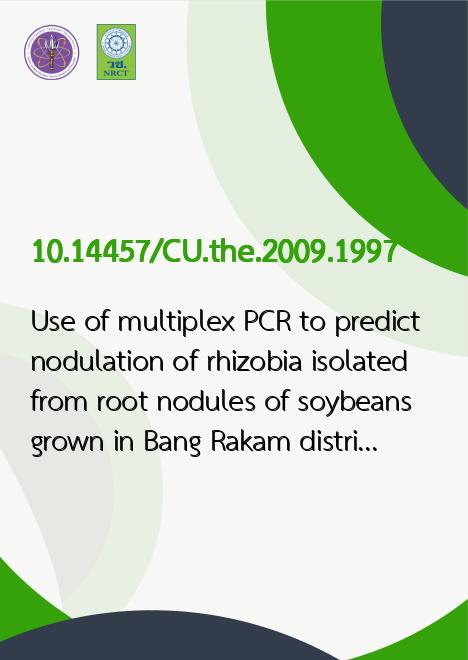
|
Use of multiplex PCR to predict nodulation of rhizobia isolated from root nodules of soybeans grown in Bang Rakam district soils, Phitsanulok province |
|---|---|
| รหัสดีโอไอ | |
| Title | Use of multiplex PCR to predict nodulation of rhizobia isolated from root nodules of soybeans grown in Bang Rakam district soils, Phitsanulok province |
| Creator | Nichanun Karbkesorn |
| Contributor | Kanjana Chansa-ngavej |
| Publisher | Chulalongkorn University |
| Publication Year | 2552 |
| Keyword | Multiplex PCR, Soybean, Rhizobium |
| Abstract | Soybean rhizobia are motile, non-spore-forming, Gram negative bacteria. When in soybean root nodules, these rhizobia change atmospheric nitrogen to ammonia for soybeans’ use for growth. Traditionally, nodulation property of soybean rhizobia is determined by inoculating each soybean rhizobium strain in Leonard jars containing germinating soybean seeds. Soybeans are grown for 28 days before observing numbers of crown and total number of nodules. This method is labor-intensive and time-consuming. The aims of this research are to find optimal conditions for multiplex PCR reaction for use in the prediction of nodulation efficiency of 33 slow-growing soybean rhizobium strains isolated from Bang Rakam district, Phitsanulok province. In addition, identification of 5 slow-growing soybean rhizobia by polyphasic taxonomy will be carried out in this research. The results obtained indicated that the optimized conditions for the multiplex PCR reaction were 200 ng target DNA and concentrations of primer nodD1F, nodD1R, nodYF, and nodYR were 8.0, 12.5, 12.5 and 8.0 pmoles respectively. Separation of the multiplex PCR products by agarose gel electrophoresis showed two multiplex PCR patterns. Pattern 1 consisted of DNA fragments of 317 bp and 657 bp while pattern 2 consisted of DNA fragments of 340 bp and 657 bp. No correlation was found between multiplex PCR patterns and nodulation efficiency in terms of the average numbers of crown and total nodules. Identification of 5 randomly selected slow-growing soybean rhizobia showed strains D361, D373, and D388 were Bradyrhizobium japonicum while strains D416 and D467 were B. liaoningense. |
| URL Website | cuir.car.chula.ac.th |